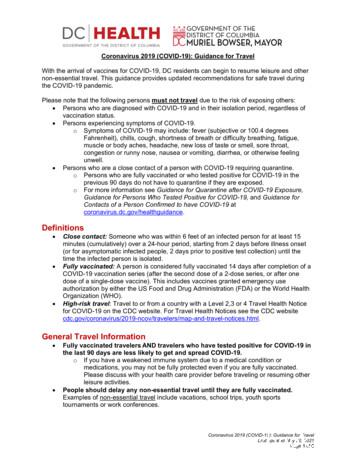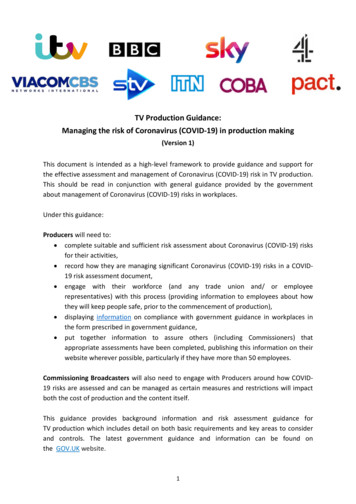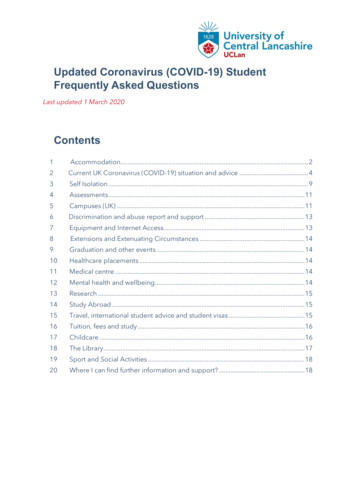Coronavirus 2019 (COVID-19): Guidance For Travel
Coronavirus 2019 (COVID-19): Guidance for TravelWith the arrival of vaccines for COVID-19, DC residents can begin to resume leisure and othernon-essential travel. This guidance provides updated recommendations for safe travel duringthe COVID-19 pandemic.Please note that the following persons should not travel due to the risk of exposing others: Persons who are diagnosed with COVID-19 and in their isolation period Persons experiencing symptoms of COVID-19.o Symptoms of COVID-19 may include: fever (subjective or 100.4 degreesFahrenheit), chills, cough, shortness of breath or difficulty breathing, fatigue,muscle or body aches, headache, new loss of taste or smell, sore throat,congestion or runny nose, nausea or vomiting, diarrhea, or otherwise feelingunwell. Persons who are a close contact of a person with COVID-19 requiring quarantine.o Persons who are fully vaccinated or who tested positive for COVID-19 in theprevious 90 days do not have to quarantine if they are exposed.o For more information see Guidance for Quarantine after COVID-19 Exposure,Guidance for Persons Who Tested Positive for COVID-19, and Guidance forContacts of a Person Confirmed to have COVID-19 atcoronavirus.dc.gov/healthguidance.Definitions Close contact: Someone who was within 6 feet of an infected person for at least 15minutes (cumulatively) over a 24-hour period, starting from 2 days before illness onset(or for asymptomatic infected people, 2 days prior to positive test collection) until thetime the infected person is isolated.Fully vaccinated: A person is considered fully vaccinated 14 days after completion of aCOVID-19 vaccination series (after the second dose of a 2-dose series, or after onedose of a single-dose vaccine).High-risk travel:Travel to or from a country with a Level 2,3 or 4 Travel Health Notice for COVID-19 onthe CDC website. For Travel Health Notices see the CDC -and-travel-notices.html.General Travel Information Fully vaccinated travelers are less likely to get and spread COVID-19.o This includes people who are fully vaccinated with an FDA-authorized vaccine ora vaccine authorized for emergency use by the World Health Organizationo People with a history of confirmed COVID-19 infection and recovery within thelast 90 days may also resume non-essential travel.o If you have a weakened immune system due to a medical condition ormedications, you may not be fully protected even if you are fully vaccinated.Please discuss with your health care provider before traveling or resuming otherleisure activities.People should delay any non-essential travel until they are fully vaccinated.o Examples of non-essential travel include vacations, school trips, youth sportstournaments or work conferences.Coronavirus 2019 (COVID-19): Guidance for TravelLast updated May 18, 2021Page 1 of 6
All travelers, including those who are fully vaccinated, should:o Wear a face mask. Masks are most effective if they fit snugly to the face overyour nose and mouth and have 2-3 layers of tightly woven fabric.o Stay 6 feet from others and avoid crowds.o Wash your hands often or use hand sanitizer.o Avoid travel to high-risk countries.For any travel related testing, a viral test (PCR or antigen test) should be used. APCR test is preferred over an antigen test.o Do not travel while your test result is pending.o If the test returns positive, isolate and do not travel.Domestic TravelFully vaccinated people Fully vaccinated people (or people who tested positive for COVID-19 in the previous 90days) may travel within the United States without the need for pre- or post-travel COVID19 testing or travel-related quarantine, as long as they do not have symptoms of COVID19. It is recommended to bring your vaccination card with you while travelling in casedocumentation is requested. People who have tested positive for COVID-19 more than 90 days ago and who are notvaccinated should follow directions for Unvaccinated people.Unvaccinated or Partially vaccinated people Unvaccinated people should:o Get a COVID-19 test 1-3 days before leaving on their tripANDo Get a COVID-19 test 3-5 days after returning home from their tripANDo Self-quarantine for 7 days after returning home. Even if test is negative, you still must self-quarantine for 7 days.o If no test is done, unvaccinated people must self-quarantine for 10 days afterreturning homeo Avoid being around people at high-risk for severe COVID-19 during yourquarantine period whether you had post-travel testing or not. (For moreinformation see Guidance for People with Chronic Health Conditions andGuidance for Older Adults at coronavirus.dc.gov/healthguidance.)International Travel It is important to note that all air passengers boarding an international flight to theUnited States, including US residents returning home, must show a negativeCOVID-19 test regardless of vaccination status. The COVID-19 test must beperformed no more than 3 days prior to the flight. There is an exception to the testrequirement for individuals who can provide proof of a COVID-19 infection within the last3 months.Travel to or from a country with a Level 2,3 or 4 Travel Health Notice for COVID-19 onthe CDC website is considered High Risk and is not recommended. For Travel HealthNotices see the CDC website avelnotices.html.Coronavirus 2019 (COVID-19): Guidance for TravelLast updated May 18, 2021Page 2 of 6
Restrictions for visitors change often. It is important to know what restrictions are inplace before planning and departing for international destinations. Be aware of travelrestrictions that may be in place prohibiting non-residents from entering or requiring selfisolation upon entry for visitors.Fully vaccinated people Fully vaccinated people (or people who tested positive for COVID-19 int eh previous 90days) should get a COVID-19 test 3-5 days after international travel. They do notneed pre-travel testing or quarantine, unless it is required by the destination. People who tested positive for COVID-19 more than 90 days ago and who are notvaccinated should follow directions for Unvaccinated People.Unvaccinated or partially vaccinated people Unvaccinated people should:o Get a COVID-19 test 1-3 days before leaving on their tripANDo Get a COVID-19 test 3-5 days after returning home from their tripANDo Self-quarantine for 7 days after returning home. Even if test is negative, you still must self-quarantine for 7 days.o If no test is done, unvaccinated people must self-quarantine for 10 days afterreturning homeo Avoid being around people at high-risk for severe COVID-19 during yourquarantine period whether you had post-travel testing or not. For moreinformation see Guidance for People with Chronic Health Conditions andGuidance for Older Adults at coronavirus.dc.gov/healthguidance.o A viral test (PCR or antigen test) must be used. A PCR test is preferred over anantigen test.More Information for Residents of DC After returning from travel, unvaccinated or partially vaccinated DC residents whoperform essential work may carry out duties and engage in essential activities (e.g.,obtaining food, medical care, or medications) prior to receiving results from their posttravel COVID-19 test, unless otherwise indicated by their employer.Institutions/employers may enforce stricter rules as necessary for a given setting, suchas a mandatory quarantine for travelers.More Information for Visitors to DC Travel related testing and quarantine requirements are waived for visitors cominginto DC:o From Maryland and VirginiaORo For less than 24 hoursAll visitors should self-monitor for symptoms of COVID-19 during their visit.o If symptoms develop, isolate and get tested.o If the test returns negative, continue with planned activities.o If the test is positive, isolate.Coronavirus 2019 (COVID-19): Guidance for TravelLast updated May 18, 2021Page 3 of 6
If a traveler tests positive while in DC, they must complete their isolation beforetraveling home, and any susceptible close contacts must complete the 10-dayquarantine.o A person who tests positive for COVID-19 must isolate for at least 10 days andafter improvement of symptoms, including no fever for 24 hours. Please see theguidance document “Persons Who Tested Positive for COVID-19” atcoronavirus.dc.gov/healthguidance for more details.If a traveler is identified as a close contact of a case while in DC, district officialsengaged in COVID-19 investigation efforts, such as contact tracing, enforcements, orinspections, may request negative test results, proof of vaccination or proof of SARSCoV-2 infection within the past 90 days. Visitors who do not produce requesteddocumentation must quarantine for 10 days.Private institutions, such as universities, employers, hotels, hospitals, congregate carefacilities, and houses of worship may ask visitors about their recent travel and mayrequire a record of a negative COVID-19 test, proof of vaccination, or proof of SARSCoV-2 infection within the last 90 days before allowing admittance to their facility.Essential travel to DC Persons traveling into DC from elsewhere in the United States (except Maryland andVirginia) for essential travel who are unvaccinated, partially vaccinated, or have nohistory of COVID-19 in the previous 90 days should:o Get a COVID-19 test prior to travelling if they have more than 1-week notice oftheir trip to DC.o Limit activities to the primary purpose of your visit and avoid public settings asmuch as possible.Essential travel includes: Travel related to the provision of, or access to, Essential Activities, EssentialGovernmental Functions, Essential Businesses, or Minimum Basic Operations, includingtravel to and from work to operate Essential Businesses or maintain EssentialGovernmental Functions Travel to care for elderly, minors, dependents, persons with disabilities, or othervulnerable persons Travel required to visit a house of worship Travel to attend a family funeral Travel for a family emergency Travel to or from educational institutions for purposes of receiving materials for distancelearning, for receiving meals, and any other related services For those commuting to and from the District for essential activities, travel for residentsto return to a place of residence in Washington, DC and for non-residents to return totheir place of residence outside Washington, DC Travel required by law enforcement or court order Travel within the National Capital RegionIf You Develop Symptoms While Traveling All travelers, regardless of vaccination status or COVID-19 history, must selfmonitor before, during and after travel for any symptoms of COVID-19.If you develop symptoms while traveling:Coronavirus 2019 (COVID-19): Guidance for TravelLast updated May 18, 2021Page 4 of 6
Isolate yourself from others.Consult with a healthcare provider and seek testing. Call ahead and let themknow your symptoms.o Only leave your lodging/home for essential purposes, such as seekinghealthcare/testing.o You or someone with you should call 911 if you are having a medical emergency,such as difficulty breathing or shortness of breath, persistent chest pain orpressure, bluish lips or face, confusion, or loss of consciousness.If you need a COVID-19 test, information on options for COVID-19 testing are availableat coronavirus.dc.gov/testing.For more information about what to do if you are diagnosed with COVID-19 seeGuidance for Persons who Tested Positive for COVID-19 atcoronavirus.dc.gov/healthguidance.oo Considerations for Safer Travel All travelers, regardless of vaccination status or personal history of COVID-19,should:o Consider whether the risks of travel for yourself and others outweigh the benefitof that travel. Older adults or people with underlying health conditions are at anincreased risk for complications from COVID-19 and should be especiallycautious. If COVID-19 is spreading where you are going, you can get infected whiletraveling and spread it to members of your household when you return. If COVID-19 is still spreading in your community, you can potentiallyspread the virus to others while traveling, even if you don’t havesymptomso Continue to follow everyday precautions while traveling such as wearing masks,social distancing, and frequent hand hygiene. NOTE: Masks are required on airplanes, buses, trains, and otherforms of public transportation, and at transportation hubs (e.g.,airports, train stations).o Choose safer travel options. For example: Safer: contact during travel only with members of your own household contact only with fully vaccinated people Less safe: Close contact with people not from your household Contact with unvaccinated people AVOID: crowdso Your activities during travel will greatly affect your risk. In general, outsideactivities are much safer than indoor activities. Activities with householdmembers are much safer than activities with persons from many households.Visit the CDC Travel Planner website nner/index.html) and Travel Recommendations by s/map-and-travel-notices.html) to get importantinformation about COVID-19 restrictions by destination before traveling.Risks associated with travel methodsCoronavirus 2019 (COVID-19): Guidance for TravelLast updated May 18, 2021Page 5 of 6
Travel by private vehicle is safest and is strongly encouraged whenever possible.o Safer: short road trips with members of your householdo Less safe: Longer trips with many stops along the way Making stops along the way for gas, food, or bathroom breaks can putyou and your traveling companions in close contact with other people andas well as into contact with potentially contaminated surfaces.Air travel: Air travel requires spending time in security lines and airport terminals, whichcan bring you in close contact with other people and frequently touched surfaces. Mostviruses and other germs do not spread easily on flights because of how air circulatesand is filtered on airplanes. However, social distancing is difficult on crowded flights, andyou may have to sit near others (within 6 feet), sometimes for hours, increasing risk ofexposure to COVID-19o Safer: flights with no stops or layoverso Less safe: flights with multiple legs or layoversBus or train travel: Traveling on buses or trains for any length of time can involve sittingor standing within 6 feet of others.o AVOID: long distance bus or train tripsCruise ships: The Centers for Disease Control and Prevention (CDC) recommendsavoiding all cruise or riverboat travel worldwide.Anticipate travel needs to decrease exposures Bring enough medicine for the entire trip. Pack alcohol-based hand sanitizer (at least 60% alcohol) and keep it with you. Bring cloth face coverings or masks to wear in public places, including outdoor areaswhere it is difficult to maintain social distancing. Prepare food and water for your trip. Pack non-perishable food in case restaurants andstores are closed. If you clean your travel lodgings, see the CDC’s guidance on cleaning and fect.Follow state and local travel restrictions For up-to-date information and travel guidance, check the state or local healthdepartment where you are, along your route, and at your planned destination. A list ofstate and territorial health department websites can be found on the CDC ies/healthdepartments.html. While you are traveling, it is possible a state or local government may put into placetravel restrictions, such as stay-at-home or shelter-in-place orders, mandatedquarantines upon arrival, or even state border closures. Check for updates as you travel.These recommendations will continue to be updated. Please visit coronavirus.dc.gov regularlyfor the most current information.Coronavirus 2019 (COVID-19): Guidance for TravelLast updated May 18, 2021Page 6 of 6
May 17, 2021 · Coronavirus 2019 (COVID-19): Guidance for Travel Last updated May 18, 2021 Page 1 of 6. Coronavirus 2019 (COVID-19): Guidance for Travel . With the arrival of vaccines for COVID-19, DC residents can begin to resume leisure and other non-essential travel. This guidance provides updated reco
May 19, 2021 · Coronavirus 2019 (COVID-19): Guidance for Travel Last updated May 20, 2021 Page 1 of 6 Coronavirus 2019 (COVID-19): Guidance for Travel With the arrival of vaccines for COVID-19, DC residents can begin to resume leisure and other non-essential travel. This guidance provides updated recommendations for s
Managing the risk of Coronavirus (COVID-19) in production making (Version 1) This document is intended as a highlevel framework to provide guidance and support for - the effective assessment and management of Coronavirus (COVID19) risk in TV production. - This should be read in conjunction with general guidance provided by the government about management of Coronavirus (COVID-19) risks in .
Questions fréquentes : COVID-19 et tuberculose Version 2, 22 avril 2020. Cette version remplace toutes les autres versions. Le nouveau coronavirus ou coronavirus 2 du syndrome respiratoire aigu sévère (SARS-CoV-2) est un nouveau coronavirus récemment découvert en 2019. Le virus est à l'origine de la maladie à coronavirus 2019 (COVID-19).
2 Current UK Coronavirus (COVID-19) situation and advice What is the current UK situation regarding Coronavirus? The current coronavirus alert level in the UK is 4, which means Covid-19 is in general circulation, transmission is high or rising and current social distancing measures and restrictions are in place. From 5 January 2021 the Government imposed a national lockdown. This means .
168 Hanes House—Trent Drive DUMC 102359 Durham, NC 27710 . Coronavirus Disease 2019 (COVID-19)* (*updated March 19, 2020) Background: Coronaviruses are a large family of viruses that cause respiratory illnesses of varying severity from a mild "common cold" to a more severe illness like SARS, MERS-CoV, and now Coronavirus Disease 2019 (COVID-
CDC Guidelines for Visiting Parks and Recreation Facilities Guidance for Businesses and Employers Responding to Coronavirus Disease 2019 (COVID-19) COVID-19 Guidance for Aquatics COVID-19 Guidance for Businesses and Employees OSHA COVID-19 Control and Prevention CDC Guidance So
Coronavirus (COVID-19) Pandemic: Safe Opening and Operation Work Eligible for Public Assistance (Interim) FEMA Policy FP-104-21-0003 . BACKGROUND . Under the March 13, 2020, Coronavirus (COVID-19) nationwide emergency declaration. 1. and subsequent major disaster declarations for COVID-
Grade 2 Home Learning Packet The contents of this packet contains 10 days of activities in paper copy. Students should be completing this packet, along with completing lessons on their math/reading online programs daily. If we surpass the 10 days without school, students should continue using their online math and reading programs for 45 minutes per day per program unless otherwise specified .























